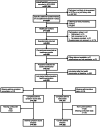Occupational Exposure Patterns to Disinfectants and Cleaning Products and Its Association With Asthma Among French Healthcare Workers
- PMID: 40268382
- PMCID: PMC12070147
- DOI: 10.1002/ajim.23725
Occupational Exposure Patterns to Disinfectants and Cleaning Products and Its Association With Asthma Among French Healthcare Workers
Abstract
Background: Disinfectants and cleaning products (DCPs) are important asthma risk factors among healthcare workers. However, healthcare work involves heterogenous cleaning tasks and co-exposure to many chemicals. These multidimensional aspects have rarely been considered. We aimed to identify patterns of occupational exposure to DCPs and study their associations with asthma.
Methods: CONSTANCES is a French population-based cohort of ≈220,000 adults. Current asthma and asthma symptom score were defined by questionnaire at inclusion (2012-2021). Healthcare workers completed a supplementary questionnaire on their current/last held occupation, workplace, and cleaning activities that were used in unsupervised learning algorithms to identify occupational exposure patterns. Logistic and negative binomial regression models, adjusted for potential confounders, were used to assess associations with asthma outcomes.
Results: In 5512 healthcare workers, four occupational exposure clusters were identified: Cluster1 (C1, 42%, reference), mainly characterized by low exposed nurses and physicians; C2 (7%), medical laboratory staff moderately exposed to common DCPs (chlorine/bleach, alcohol); C3 (41%), nursing assistants and nurses highly exposed to a few DCPs (mainly quaternary ammonium compounds); and C4 (10%), nurses and nursing assistants highly exposed to multiple DCPs (e.g., glutaraldehyde, hydrogen peroxide, and acids). Among women (n = 3734), C2 (mean score ratio [95% CI]: 1.31 [1.02; 1.68]) and C3 (1.18 [1.03; 1.36]) were associated with higher asthma symptom score, and an association was suggested between C3 and current asthma (odds ratio 1.22 [0.99; 1.51]).
Conclusion: In a large population of healthcare workers, four DCP exposure patterns were identified, reflecting the heterogeneity of healthcare jobs. Two patterns, including one characterized by laboratory workers, were associated with greater asthma symptoms in women.
Keywords: asthma; cleaning and disinfecting products; clustering; healthcare workers; occupational exposure.
© 2025 The Author(s). American Journal of Industrial Medicine published by Wiley Periodicals LLC.
Conflict of interest statement
The authors declare no conflicts of interest.
Similar articles
-
Occupation and task as risk factors for asthma-related outcomes among healthcare workers in New York City.Int J Hyg Environ Health. 2019 Mar;222(2):211-220. doi: 10.1016/j.ijheh.2018.10.001. Epub 2018 Oct 13. Int J Hyg Environ Health. 2019. PMID: 30327176 Free PMC article.
-
Clustering asthma symptoms and cleaning and disinfecting activities and evaluating their associations among healthcare workers.Int J Hyg Environ Health. 2019 Jun;222(5):873-883. doi: 10.1016/j.ijheh.2019.04.001. Epub 2019 Apr 19. Int J Hyg Environ Health. 2019. PMID: 31010790 Free PMC article.
-
Asthma among workers in healthcare settings: role of disinfection with quaternary ammonium compounds.Clin Exp Allergy. 2014 Mar;44(3):393-406. doi: 10.1111/cea.12215. Clin Exp Allergy. 2014. PMID: 24128009
-
Cleaners and airway diseases.Curr Opin Allergy Clin Immunol. 2021 Apr 1;21(2):101-109. doi: 10.1097/ACI.0000000000000710. Curr Opin Allergy Clin Immunol. 2021. PMID: 33284160 Review.
-
Update on asthma and cleaners.Curr Opin Allergy Clin Immunol. 2010 Apr;10(2):114-20. doi: 10.1097/ACI.0b013e32833733fe. Curr Opin Allergy Clin Immunol. 2010. PMID: 20093933 Free PMC article. Review.
References
MeSH terms
Substances
LinkOut - more resources
Full Text Sources
Medical
Miscellaneous


